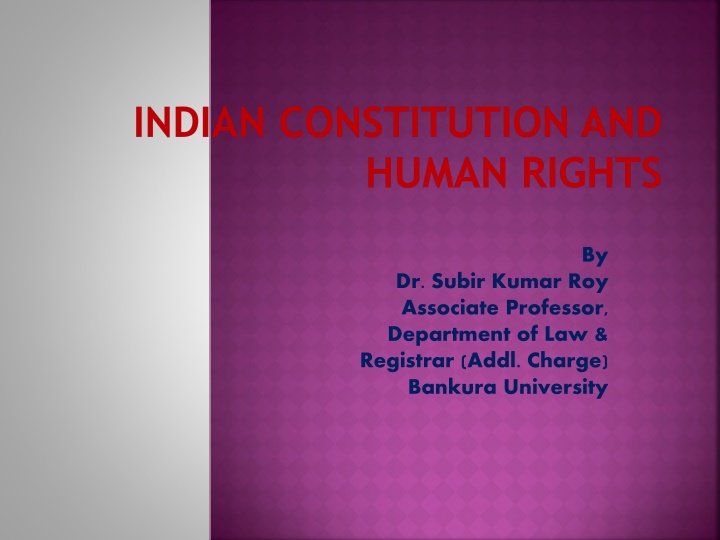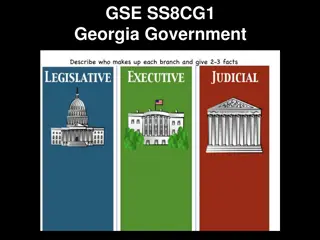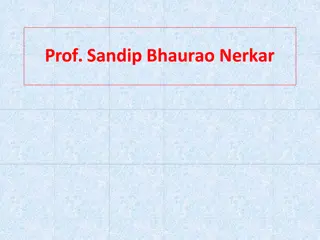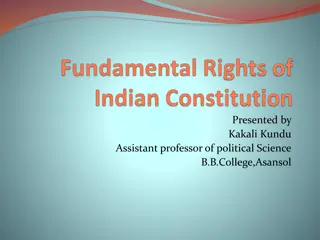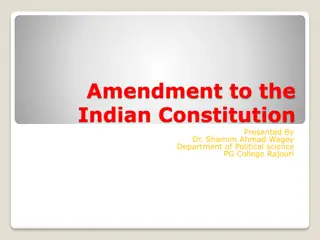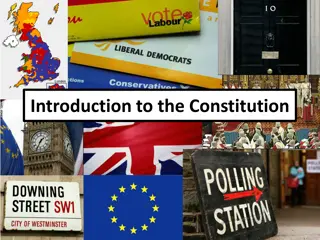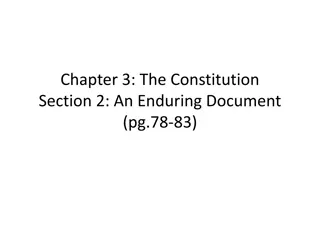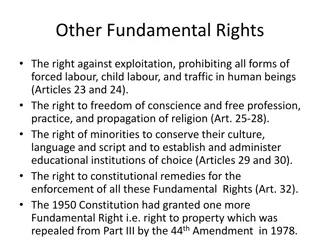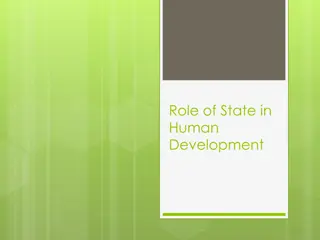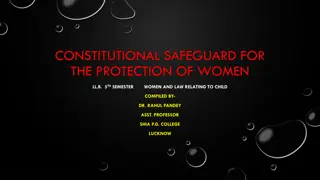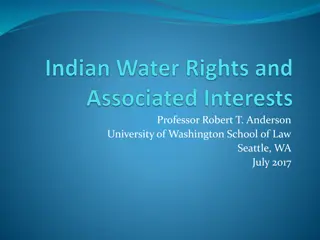Indian Constitution and Human Rights: A Comprehensive Overview
The Indian constitution embodies justice in social, economic, and political spheres, aiming for the full development of every individual. Rooted in democratic principles and socialism, the preamble emphasizes liberty, equality, and justice. Drawing wisdom from leaders like Dr. Ambedkar and Mahatma Gandhi, the constitution puts the people at its core, recognizing them as the source of power. The document reflects the aspirations and hopes of the nation, setting the foundation for a sovereign, socialist, secular, democratic, and republic India.
Download Presentation

Please find below an Image/Link to download the presentation.
The content on the website is provided AS IS for your information and personal use only. It may not be sold, licensed, or shared on other websites without obtaining consent from the author.If you encounter any issues during the download, it is possible that the publisher has removed the file from their server.
You are allowed to download the files provided on this website for personal or commercial use, subject to the condition that they are used lawfully. All files are the property of their respective owners.
The content on the website is provided AS IS for your information and personal use only. It may not be sold, licensed, or shared on other websites without obtaining consent from the author.
E N D
Presentation Transcript
INDIAN CONSTITUTION AND HUMAN RIGHTS By Dr. Subir Kumar Roy Associate Professor, Department of Law & Registrar (Addl. Charge) Bankura University
So far Indian constitutional mechanism is concerned it envisages tripartite picturesque of justice i.e., justice in social, economic and political front. The concept of justice is enshrined in the constitution to actualize the goal of full and free development of every individual. The above concept represents the constitution as a document to symbolize the hopes and aspirations of the people. The preamble clarifies in clear terms about the resolution of the people to constitute India into a Sovereign, Socialist, Secular Democratic and Republic one. The above stand signifies of having democratic setup with a parliamentary system of Government, but blended with the principle of socialism in tune with the Nehruvian Model of economy.
Preamble assures Liberty of thought, expression, belief, faith, and worship; promotes equality, fraternity and maintains dignity. Equality and justice are the foundational bedrock on which the edifice of the Indian constitution rocks on. In this regard perhaps it is apt to quote Dr. Ambedkar who said, The first condition which I think is a condition precedent for the successful working of a democracy is that there must not be any glaring inequalities in the society. There must not be an oppressed class. There must not be a class, which has got all the privileges, and a class, which has got all the burdens to carry. Such a thing, such an organization of society has within itself the germ of a bloody revolution and perhaps it would be impossible for democracy to cure them (Thus spoke Ambedkar, Vol-I, p-48) . Certainly, the above thought works at the time of compiling the constitution of India. perhaps the philosophy behind the preamble of our constitution will not complete without quoting Mahatma Gandhi who suggested the national leaders that when doubt about desirability of any policy or programmes will arise, they should recall the face of the poorest man in the country and see in the proposed policy or programme was likely to benefit them. (Subhas Kasyap,s book, Human Rights and Parliament, P-94)
Like the constitution of USA, preamble of Indian constitution also begins with the very phraseology i.e. We the People which make it clear that the founding fathers were committed to establish the government of the people and not of the states. The people are the driving force of the constitution and hence, the constitution is the supreme law of the land. Here it is apt to quote President Monroe who opined, The people, the highest authority known to our system from which all our institutions spring and whom they depend formed it. In India also in unequivocal terms and forcibly it has been clarified that We the People are the source of the Indian constitution. So the Indian constitution emanates from the people, its power are granted by the people and will be applied and exercised for their benefits. The various organs of the government get power from the constitution and beside the constitutional control they are also subjected to the control of the people but at the same time the people are supposed to use this control in legitimate mode.
The mechanism of ensuring of justice and the concept of liberty, equality, dignity, fraternity as mentioned in the preamble, is contained in part III and part IV of the Indian constitution respectively deals with the fundamental rights and directive principles. Both the fundamental rights and directive principles constitute a code of human rights. The fundamental rights comprise mainly of civil and political rights and they are justifiable in the courts of law. On the other hand Directive Principles of State Policies comprise of social, economic and political rights and may not be justifiable in the courts of law as it is possible in the matter of fundamental rights but under Art. 37, these Directives have been declared to be fundamental in the governance of the country.
Bhagwati J. points out that inclusion of a set of directive principles in the text of the constitution itself is a reminder to political and judicial functionaries alike that the constitution is not just intended to umpire the power games of those in power but to attain certain social and economic objectives[1]. He observes, they reinforce the view that the constitution is not confined to just allocating power between various institutions and authorities but it goes much further and it embodies certain basic values on which the entire edifice of the constitution depends. One of the most basic of these values is the realization of social justice [2] so the Directive Principles have been incorporated with a view to achieve social and economic democracy because it has been rightly perceived by the constitution makers that mere political democracy would be meaningless in a country of the poor millions without economic justice. [1] Referred by Mool Chand Sharma in his book, Justice P.N. Bhagwati Court Constitution and Human Rights, Universal Book Traders,(1995,57) [2] ibid
The preamble, fundamental rights and the directive principles are considered as trinity of the constitution. So far the relationship in between fundamental right and directive principles are concerned earlier at one point of time the Indian judiciary was of the view that fundamental rights will prevail over the directive principle of state policies but gradually the judiciary has started to change its view over the matter which can be evident through the decision of the Supreme Court in Md. Hanif Qureshi v/s State of Bihar (AIR 1958 SC 731) where it has been stated that there exist harmony in between the fundamental rights and directive principle of state policy. In Minerva Mills v/s Union of India (AIR 1980 SC 1789) it has been opined by the Chandrachud C.J. that fundamental rights are not an end in themselves but are the means to an end and that leads towards the directive principles. He observed that the fundamental rights and directive principles constitute the core of commitment to social revolution and they, together are the conscience of the constitution. Now it is a settled rule and understanding of the judiciary to construe the fundamental rights in the light of the objects set forward in DPSP.
The fundamental rights provided under part III contains almost all the important rights guaranteed in the covenant of civil and political rights and for this of course the credit goes to the framers of our constitution as they incorporated these rights long before the passing of the above covenant. However at the same time we should not forget that the concept of fundamental right we have taken from the US constitution. These rights can be classified into the following:- Rights to equality (Art. 14 to Art.18) Fundamental freedoms (Art. 19 Art.22) Right against exploitation (Art.23-Art.24) Right to religion (Art.25-Art.28) Certain education and cultural Rights guaranteed to minorities (Art. 29-Art.30) Right to constitutional remedies (Art.32-Art.35) Right to education (Art.21A)
On the other hand directive principles fix certain social, cultural, economic goals by bringing about a non-violent revolution. The directive principle of state policy can be classified into following: Social and economic charter comprises of Art. 38 and Art.39 which respectively deals with the promotion of welfare of the people, ensuring economic justice with ensuring equal right of man and woman. Social security charter Art. 39A, 41, 42, 43,45,46,47 etc. which respectively deals with the equal justice and free legal aid, right to work and education, just and human condition of work, ensures participation of workers in management and living condition in work place, free and compulsory education for children, promotion of education and economic interest of weaker sections, improvement of health and raising standard of life etc. Community welfare charter comprises of Art. 44, 48,48A, 50,51 respectively deals with the uniform civil code, agriculture and animal husbandry, improvement of environment and protection of national heritage, independence of judiciary, ensuring international peace etc.
The wide dimension of DPSP shows that the Covenant of Social Economic and Cultural rights are replica of each other. The strong and vigilant public opinion is the real force behind the enforcement of the rights provided under part IV of the Indian Constitution. Apart from the Preamble, fundamental rights and DPSP of the constitution, Art.253 is required to be mentioned separately, which empowers the parliament to enforce any treaty, covenant, convention etc. entered with any foreign countries.
